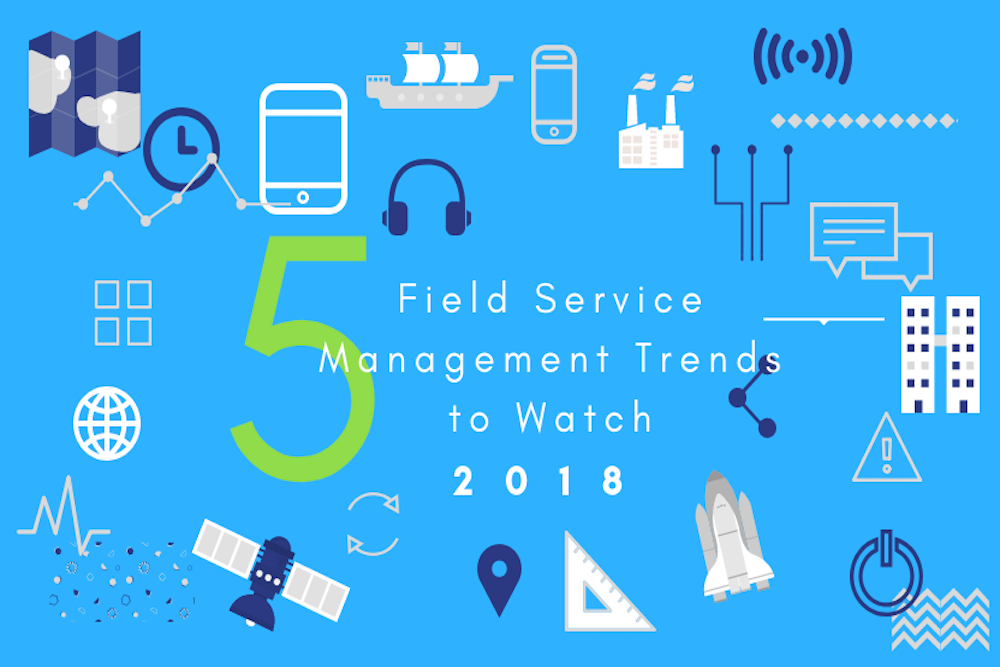
I talk with field service organizations on a daily basis, and it’s always interesting when I notice patterns emerge with regard to what features or functionality they need to go digital. Or, maybe they’re looking to level-up their customer service experience. Over the past few months, a number of similar requirements have come across my desk that I feel it’s an educational opportunity for field service organizations looking to embark on their digital transformation journey. Here, I break down 5 field service management trends to watch in 2018.
Field Service Management Trend #1: Improving the Customer Service Experience
It’s only natural for field service organizations to pay strict attention to their customer service experience, especially given we’re in what’s known as The Age of the Customer (see this summary from Gainsight). There is a tremendous focus on improving the customer service experience, because customers hold much more power through online reviews, social media and general availability to information for comparison shopping.
What I see trending is the requirement to be able to send notifications before, during and after a work order has been completed; schedule/reschedule a work order in real-time; and allow customers to see a full history of their work orders. Given the increasing focus on improving the customer experience, I would not be surprised if this stayed at the top of this list in 2019.
Field Service Management Trend #2: Reporting on Technician Performance
As any field service organization knows, a highly distributed field workforce comes with the territory; it’s the nature of the work. On any given day, a technician could complete one or multiple work orders at many different locations. The ability to report on individual, as well as overall team performance, is a necessity. In fact, we tell our customers that from day one. If you can’t track, measure and report on key field performance metrics related to technician performance, how else will you be able to benchmark and improve work order efficiency?
We saw this trend really begin to take focus in 2017, and it’s already grown over 2018. Expect additional focus on field service management trending toward individual technician performance reporting capabilities.
Field Service Management Trend #3: Integrating with Time-Sheet and HR Systems
Somewhat related to the aforementioned trend, I’ve noticed an increase in field service organizations seeking the ability to integrate with their back-office time-sheet and HR/payroll system(s). The goal is to enable a technician to enter information right from the field service management application on their mobile device, saving him/her time and reducing the need to manually update multiple systems with the same information.
While I’ve been asked this question in the past, it has been gaining momentum in recent weeks. Over the course of 2018, I expect that trend to continue and possibly bleed into early 2019.
Field Service Management Trend #4: Automating Alerts on Assets
Most field service organizations maintain a wide range of assets (i.e., plant, property, equipment) across many different locations. Not surprisingly, many of our customers maintain hundreds to thousands of assets around the world. Managing where, when and how assets are performing can be greatly improved through field service management software.
Taking that one step further, connecting assets to the FSM is a quick way to enable the remote monitoring of assets in real-time. Many of our customers connect their assets and automate alerts when something is out of range or for scheduled maintenance.
Given the increasing discussion in the field service space about digital transformation, it’s no wonder this has been a growing trend. This type of automation can’t be accomplished with paper-based processes and workflows. That’s why this trend came in at #3 on the list, though I expect it may make its way to the top in the coming years.
Field Service Management Trend #5: Enabling Better Decision Making
A growing area of curiosity I’ve witnessed over the past few months centers on enabling better decision making while in the field. When I talk with field service organizations about what it is they are looking for, they’re really seeking a solution that has the ability to upload, store and digitize their traditionally paper-based instruction manuals and step-by-step guides.
Now, that same information is accessible via the field technician’s mobile device. For instance, a technician is in the field near an asset that may need servicing. Information pops-up detailing the asset, its location and the history of maintenance. The application is almost anticipating what the field technician will need to know next and presents that information to them or makes it easy to bring that information up on their mobile device. Additionally, the technician may see time-series trending data such as fluctuations in temperature and/or pressure to gain context-aware understanding if the asset is operating properly or if it requires servicing.
Typically, the customers I’ve spoken with want to achieve two main goals: 1) increase first-call resolution rates and 2) be more proactive at maintaining an asset before it fails. In some instances, if one asset fails, it can create a domino effect. By providing field technicians with better decision-making tools, organizations can mitigate outages and catastrophic failure of entire systems.
In the end, these 5 field service management trends are the most prominent I’ve witnessed or heard from field service organizations over 2018 so far. I expect the 2019 list may be entirely different, as emerging technologies such as AI, IoT and AR or VR are adopted by field service organizations at an increasing rate. For now, this is the way I see it. Did I miss anything? Tweet @fieldsquared if you think I missed a trending concept or topic in field service management.


